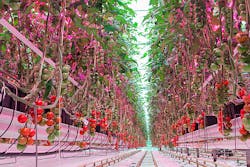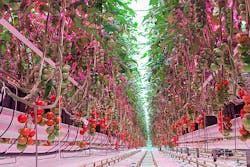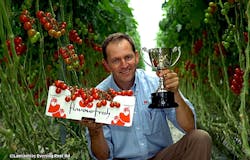APS Salads and Flavour Fresh Solfresh Group have completed year-long trials using solely LED-based horticultural lighting in a greenhouse environment to produce tomatoes throughout the year.
Philips Lighting has announced the completion of two trial LED horticultural lighting projects in the UK focused on growing tasty tomatoes year round with the solid-state lighting (SSL) products being used exclusively, as opposed to as a complement to high-pressure sodium (HPS) lighting. APS Salads, a supplier to leading UK food retailers, has been using an LED-based system for the past 12 months while Flavour Fresh Solfresh, a produce supplier to UK supermarkets, has completed 10 months of greenhouse operations using solely LEDs.
Interested in articles & announcements on horticultural lighting?
As we reported in a recent feature article, LED lighting is a burgeoning trend in horticultural applications ranging from urban vertical farms producing leafy greens to greenhouse operations where vegetables and fruits are grown. Vertical farms are a relatively new concept and have been essentially enabled by LED sources that don’t generate heat. But tomatoes, and other produce where biomass is critical, have long been grown in greenhouses using HPS lighting. HPS was selected based on energy efficiency, although as the linked article mentions, many believe that the spectrum of HPS lighting is a good match for plants where biomass is the goal.
However, LEDs offer growers the chance to precisely match a light recipe to a specific plant or to various stages of the plant growth cycle. Light recipes will be a key topic at our upcoming Horticultural Lighting Conference that will take place October 12 in Chicago. LEDs also further reduce energy use relative to HPS lighting.
For APS Salads, LEDs are proving more economical for year-round production, and the lack of heat generated has had a positive impact on the crop. "After 12 months with 100% LED, we are growing consistent quality tomatoes right through the winter that taste as good as mid-summer ones," said Phil Pearson, group development director at APS Salads and chair of the British Tomato Growers' Technical Committee. "Before with the hybrid HPS/LED system, we couldn't achieve consistent crops at an affordable cost, and we were also producing too much heat via HPS lighting in the winter."
The cost issue largely comes down to energy costs and the low maintenance inherent in SSL. "We are using two-thirds less power compared to when we were running HPS-lit greenhouses," said Pearson. "Plus we can better control the crop balance because we have total control over the heating and lighting as well as a strong ROI. The new more sustainable system will have paid for itself within three years."
Flavour Fresh Solfresh, meanwhile, had been growing its Sweet Rosso, Piccolo, Santini, and Tomkin varieties of tomatoes in a greenhouse using only natural light. The grower produced no tomatoes for four months in the winter, but now will deliver product year round with the LED lighting in place. Moreover, based on its trial, the grower expects a 30% increase in yield even during the warmer months.
"The dawning of the LED era is without doubt the greatest innovation in horticulture since the invention of the tractor," said Andy Roe, production manager at Flavour Fresh. "Phillips Lighting has developed horticultural LED light to unlock the science of plant physiology and passed on this technical wizardry to benefit growers and food consumers. The total LED installation gives 100% control to us as a grower. The lighting and heating work hand in hand to reduce the need for ventilation and in turn, this reduces the total energy requirement by up to 35%, which is a win, win situation for the environment."
Both of the tomato growers are using products from the Philips GreenPower product line. And one other advantage of LED lighting in horticulture is the use of so-called interlighting to deliver light to the lower foliage on a plant that would not normally receive much light from above. Indeed, both of these projects use a combination of LED top lighting and interlighting, and the GreenPower family includes both types of products.
Philips did not reveal exactly which of its top lighting products were used in the tomato farms. The company's most recent product announcement is the tunable GreenPower Dynamic LED system that includes blue, red, far red, and white LEDs.
Both the LED and lighting sectors are increasingly delivering more products intended specifically for horticultural applications. For example, Osram announced a new horticultural fixture back in June. Also in June, Cree announced what it calls a Photo Red LED for horticulture. And just last week, Lumileds introduced the SunPlus family of mid- and high-power LEDs for horticulture including some new purple LEDs that deliver the red and blue spectral energy needed for photosynthesis.







